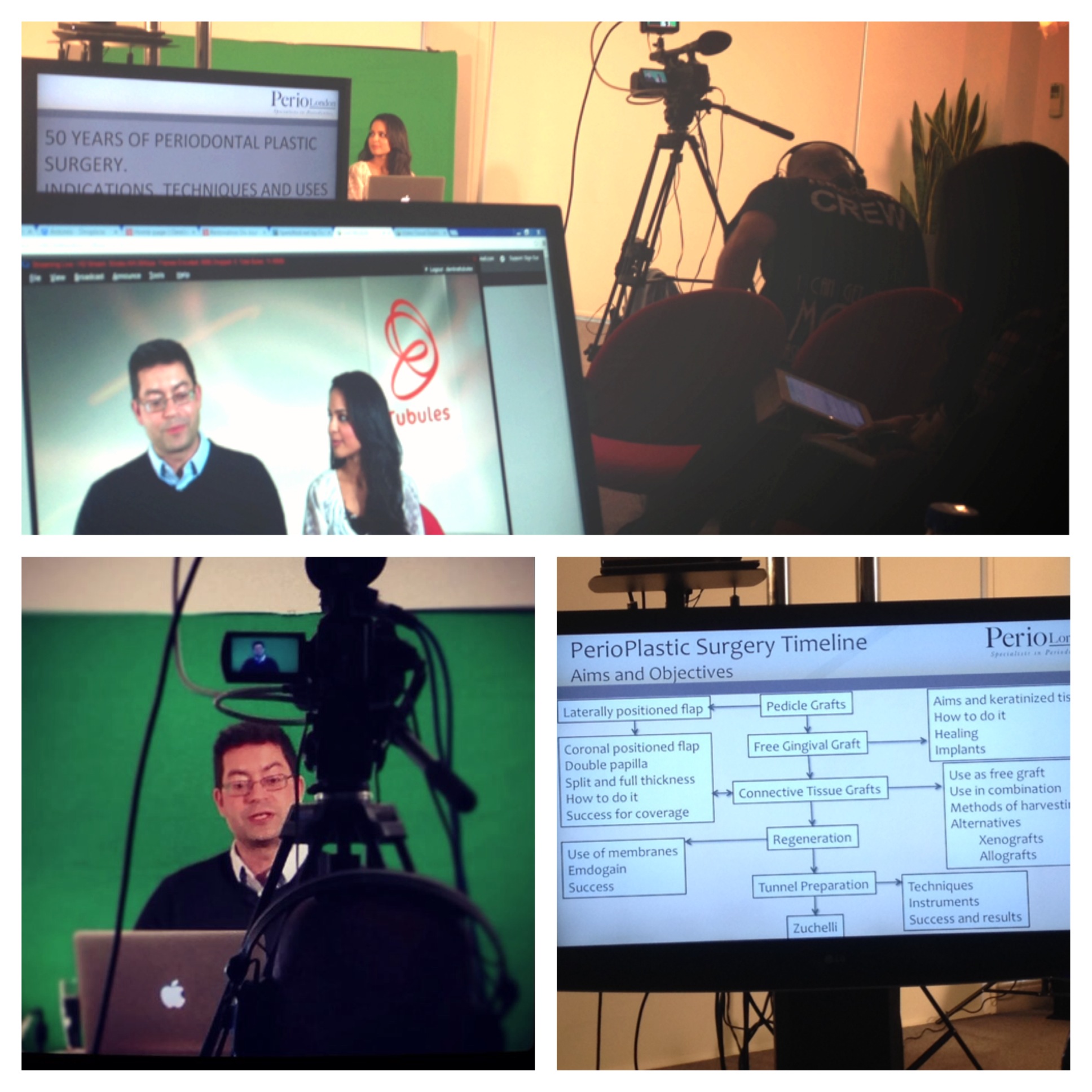April 25, 2014
 Perio Plastic Surgery Timeline
Perio Plastic Surgery Timeline
Pedicle graft –> free gingival graft –> connective tissue graft –> regeneration –> tunnel preparation –> Zuchelli technique
Recession – Miller classification
I – Labial recession not extending to the mucogingival junction. No loss of interproximal tissue.
II – Labial recession beyond the mucogingival junction. No loss of interproximal tissue.
III – Loss of interproximal tissue, labial recession apical to interproximal tissue
IV – Circumferential tissue loss
Indications for treatment (Annals of Perio 1996) – prevention of continued recession, aesthetic concerns, sensitivity, shallow root caries.
Pedicle grafts – Grupe & Warren 1956
- Simple healing: pedicle flaps retain a blood supply, need a recipient portion to provide a vascular bed, need sufficient tissue locally, margins heal by primary intention. The donor site heals by secondary intention.
- There is excellent tissue match.
- Formation of new attachment and some long junctional epithelium.
Free gingival grafts – Nabers 1966
- Indications: problems with fraenum, minimal/thin/absence of attached gingiva or inadequate vestibule.
- These grafts revascularise from the recipient bed and thus rely on the plasmatic circulation for survival.
- There is predictable healing but not predicable root surface coverage.
- The graft retains the colour of the palate so aesthetics may be compromised.
Do we need keratinised tissue around teeth?
- Lang and Loe 1972 – Experimental gingivitis in dental students – sites with less than 2 mm of keratinised tissue exhibited persisting signs of clinical inflammation.
- Miyasato 1977 – Experimental study in dental students – maintained clinically healthy tissues in area with less than 1 mm keratinised tissue.
- Wennstrom & Lindhe 1983 – Beagle dog study looking at the clinical and histological ‘health’ achieved with mechanical control – clinical inflammation more overt in regions of lining mucosa but histological examination revealed similar levels of inflammatory infiltrate.
- Treating for the sole purpose of increasing the width of keratinised tissue cannot be justified. The decision to treat should be based on the status of the tissues and ability or not to control inflammation.
Pedicle flaps (Double papillae repositioned flap) – Cohen & Ross 1968 – Gaining additional keratinised tissue from either side of the defect
Pedicle flap (Coronally positioned periodontal flap) – Bernimoulin 1975 – 2 stage procedure to add keratinised tissue, free gingival graft followed by coronally positioned flap
Connective tissue grafts (subepithelial) – Langer & Langer 1985
- Presented as a coronally positioned flap in conjunction with a connective tissue graft.
- To address the limited success of pedicle flaps especially in wide defects.
- Indications: inadequate tissue for sliding flap, isolated wide gingival recession, multiple root exposures (+/- with minimal attached tissue), recession coverage adjacent to the site requiring ridge augmentation.
Fine corrections to soft tissue using gingivoplasty – electrosurgery, laser, highspeed handpiece.
Harvesting connective tissue: Practical tips
- Multiple techniques possible – trap door, parallael incisions, single incisions.
- Single incision (Hurzeler 1999) – initial incision perpendicular to surface, 2 mm deep, bringing incision anteriorly improves access, 2nd incision raises viable superficial flap, extend to bone when apical enough, relieve mesial and distal, coronal step.
- Assess the thickness of the palate, thin plates very difficult and may lead to necrosis.
- Safe boundaries – 3-5mm from gingival margin, mesial aspect of palatal root of first molar distally, lateral incisor mesially, take into account the position of the greater palatine artery.
- Apply LA to reduce bleeding
- Dressing plate may reduce post-op bleeding and discomfort
Connective tissue alternatives
- Xenografts – Mucograft (Geislich), Mucoderm (Botiss)
- Allografts – collagen sheets derived from human donors, popular is USA, equivalent results with CAF
Regeneration
- GTR vs mucogingival surgery (Pini Prato 1992) -better coverage where initial recession was 5 mm or more, significant complications if the membrane got exposed.
- CAF and either EMD or CTG (McGuire & Nunn 2003) – same average percentage root coverage, more keratinised tissue with CTG, earlier healing and less discomfort with EMD.
- CAF with/without CTG (Cairo 2012) – same average percentage coverage, CAF + CTG better 100% coverage at 6 months, les discomfort without CTG.
Tunnel procedure
- Creation of a supra-periosteal pouch – local tissue to promote coverage, excellent tissue match, can augment with connective tissue graft.
- Start with careful sharp dissection in the margins.
- Extend one unit either side from areas to be covered.
- Use tunnelling knives to extent dissection. Create enough mobility on the flap to allow sufficient coronal and lateral movement.
- Feed in connective tissue graft from one end, secure with resorbable suture, use sling sutures to move tissue coronally.
Where are we now?
- CTG or EMD in conjuction with CAF enhances probability of complete root coverage in Miller class I or II single gingival recessions (Cairo 2008).
Experience has show:
Single recessions – localised recession <3 mm:
- >2 mm keratinised tissue – CAF with CTG/EMD
- <2 mm keratinised tissue – double papilla with CTG
- Modified tunnel is an alternative to these
Single recessions – Localised recession >3 mm:
- >2 mm keratinised tissue – CAF with CTG/EMD
- <2 mm keratinised tissue – double papilla with CTG
Multiple gingival recessions – >2mm keratinised tissue:
- 2 mm keratinised tissue – CAF with CTG or EMD
- Modified tunnel techniques
Multiple gingival recessions – <2mm keratinised tissue:
- Modified tunnel techniques
- What is the aim of treatment? Aesthetics, prevention of continued recession
- Nature of the defect – single/multiple, depth/width
- What tissue have you got to work with – local/remote donor sites
- Possible anatomical considerations – mental nerve
- Medical complications – smoking, infection risk (diabetes)
Lots of useful techniques but important to try and understand the biology and healing. Can apply the techniques to management of other surgical problems.



